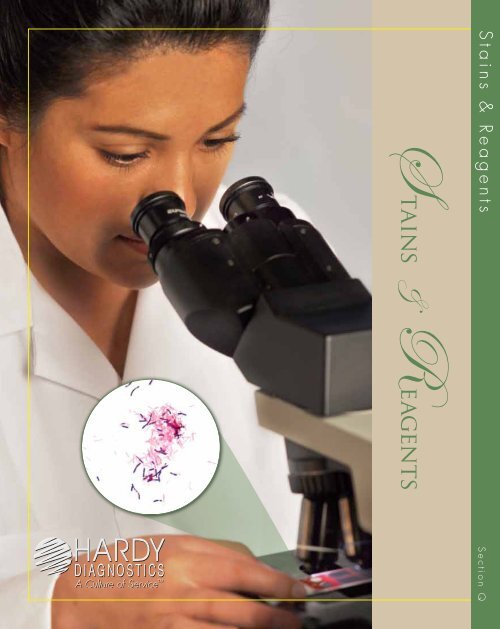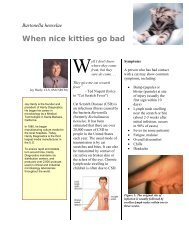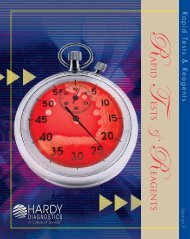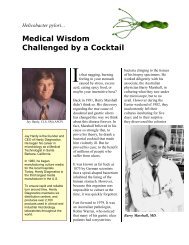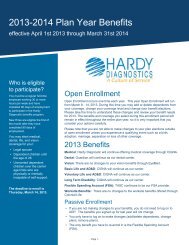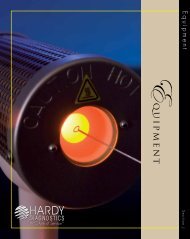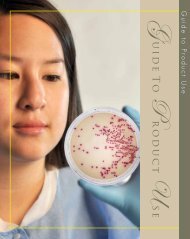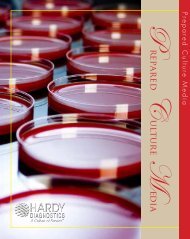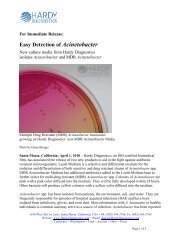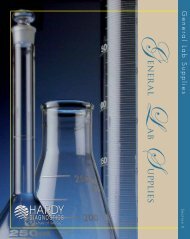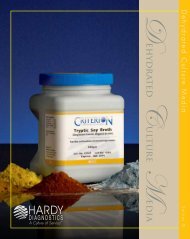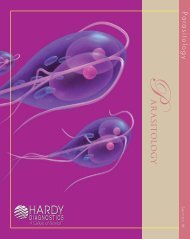Stains & Reagents - by Hardy Diagnostics
Stains & Reagents - by Hardy Diagnostics
Stains & Reagents - by Hardy Diagnostics
Create successful ePaper yourself
Turn your PDF publications into a flip-book with our unique Google optimized e-Paper software.
A Culture of Service <br />
S tains<br />
&<br />
<strong>Reagents</strong><br />
<strong>Stains</strong> & <strong>Reagents</strong> Section Q
<strong>Stains</strong> & <strong>Reagents</strong><br />
STable of Contents<br />
Q1<br />
Q4<br />
Q6<br />
Q9<br />
Q9<br />
Acid Fast TB <strong>Stains</strong><br />
& tains<br />
<strong>Reagents</strong><br />
Gram Stain Advanced <br />
Gram Stain Traditional<br />
Cryptosporidium <strong>Stains</strong><br />
Mycology <strong>Stains</strong><br />
Headquarters<br />
A Culture of Service <br />
1430 West McCoy Lane<br />
Santa Maria, CA 93455<br />
800.266.2222 : phone<br />
805.346.2760 : fax<br />
Sales@<strong>Hardy</strong><strong>Diagnostics</strong>.com<br />
www.<strong>Hardy</strong><strong>Diagnostics</strong>.com<br />
Q10<br />
Q13<br />
Q14<br />
Q15<br />
Q15<br />
Q16<br />
Q17<br />
Parasitology <strong>Stains</strong> & <strong>Reagents</strong><br />
11 Ways to Make a Better Stain<br />
<strong>Stains</strong> & <strong>Reagents</strong> Miscellaneous<br />
Staining Supplies<br />
Blood Smear <strong>Stains</strong><br />
Staining Control Slides<br />
Urinalysis <strong>Stains</strong><br />
Distribution Centers<br />
Santa Maria, California<br />
Centralia, Washington<br />
Salt Lake City, Utah<br />
Phoenix, Arizona<br />
Dallas, Texas<br />
Springboro, Ohio<br />
Lake City, Florida<br />
Albany, New York<br />
The Quality Management System at<br />
the <strong>Hardy</strong> <strong>Diagnostics</strong> manufacturing<br />
facility is certified to ISO 13485.<br />
Copyright © 2011 <strong>Hardy</strong> <strong>Diagnostics</strong><br />
Section Q
Acid-Fast TB <strong>Stains</strong><br />
The Acid-Fast Stain Kit is used as a differential method to detect those<br />
organisms which decolorize with treatment of acid alcohol, and those that do<br />
not, such as the mycobacteria.<br />
Kinyoun/Cold Method (Preferred)<br />
Specimen smear<br />
(heat or methanol<br />
fix)<br />
Carbol Fuchsin<br />
2-3 minutes<br />
required (no heat<br />
required).<br />
Water rinse<br />
Use Acid Alcohol<br />
Decolorizer until<br />
color is rinsed.<br />
Water rinse<br />
Acid Alcohol, 3% HCl in<br />
Alcohol<br />
For AFB staining, Kinyoun or Ziehl-<br />
Neelsen, <strong>by</strong> <strong>Hardy</strong> <strong>Diagnostics</strong>.<br />
250ml................................. AA008<br />
Acid-Fast Decolorizer,<br />
Sulfuric Acid 5%, in Alcohol<br />
<strong>by</strong> Medical Chemical.<br />
8 oz.................................. 3545A8<br />
AFB Stain Kit<br />
Carbol Fuchsin (Kinyoun), Acid<br />
Alcohol 3%, Methylene Blue<br />
Counterstain, <strong>by</strong> <strong>Hardy</strong> <strong>Diagnostics</strong>.<br />
3x8 oz................................. AF900<br />
Brilliant Green Counterstain<br />
For acid-fast stain procedures and<br />
other uses. 1% weight/volume. A<br />
saline solution of brilliant green.<br />
250ml................................. BG008<br />
1 gallon........................... 460A128<br />
AFB Brilliant Green Stain Kit<br />
Contains Carbol Fuchsin (Kinyoun),<br />
Acid Alcohol 3%, Brilliant Green<br />
Counterstain, <strong>by</strong> Medical Chemical.<br />
3x8 oz................................. 483KB<br />
A Culture of Service <br />
Counterstain,<br />
Methylene Blue or<br />
Brilliant Green<br />
Water rinse<br />
Carbol Fuchsin (Kinyoun)<br />
By <strong>Hardy</strong> <strong>Diagnostics</strong><br />
250ml................................. CF008<br />
16 oz................................. 483A16<br />
Methylene Blue Counterstain<br />
For acid-fast stain procedures and<br />
other uses. An aqueous solution<br />
of methylene blue, <strong>by</strong> Medical<br />
Chemical.<br />
16 oz................................. 675A16<br />
1 gallon............................675A128<br />
Acid-Fast Smear Fix<br />
For BACTEC blood cultures,<br />
for better slide adhesion<br />
of specimens, <strong>by</strong> <strong>Hardy</strong><br />
<strong>Diagnostics</strong>.<br />
15ml..........................................Z56<br />
<strong>Stains</strong> & <strong>Reagents</strong><br />
Q1
Acid-Fast TB <strong>Stains</strong><br />
Ziehl-Neelsen/<br />
Hot Method<br />
AFB Stain Kit, Ziehl-Neelsen<br />
Kit contains Carbol Fuchsin<br />
(Ziehl-Neelsen), Acid Alcohol<br />
3%, Methylene Blue Counterstain,<br />
requires heating of the slide <strong>by</strong><br />
Medical Chemical.<br />
3x8 oz.................................. 484K<br />
Acid Alcohol, 3% HCl in Acid<br />
Alcohol, Kinyoun or Ziehl-Neelsen,<br />
<strong>by</strong> <strong>Hardy</strong> <strong>Diagnostics</strong>.<br />
250ml................................ AA008<br />
Carbol Fuchsin, Ziehl-Neelsen<br />
An aqueous solution of basic fuchsin,<br />
phenol and reagent alcohol.<br />
“Hot method,” requires heating of<br />
the slide, <strong>by</strong> Medical Chemical.<br />
8 oz................................... 484A8<br />
16 oz................................484A16<br />
32 oz................................484A32<br />
Methylene Blue Counterstain<br />
Methylene blue, counterstain for acid-fast stain procedures and other uses.<br />
An aqueous solution of methylene blue, <strong>by</strong> Medical Chemical.<br />
16 oz................................675A16<br />
1 gallon........................... 675A128<br />
Q2 <strong>Stains</strong> & <strong>Reagents</strong> www.<strong>Hardy</strong><strong>Diagnostics</strong>.com<br />
Sales@<strong>Hardy</strong><strong>Diagnostics</strong>.com<br />
800.266.2222
Direct Specimen Staining<br />
Fluorescent Method<br />
AFB Fluorescent Stain Set<br />
Auramine O<br />
Auramine O stain kit includes<br />
one 8 oz bottle of each of<br />
the following: auramine O<br />
fluorescent stain, decolorizer and<br />
potassium/permanganate, <strong>by</strong><br />
Medical Chemical.<br />
3x8 oz..................................418K<br />
Auramine Fluorescent Stain<br />
An aqueous solution of phenol<br />
and auramine O Stain,<br />
<strong>by</strong> Medical Chemical.<br />
8 oz................................... 418D8<br />
1 gallon.......................... 418D128<br />
Auramine-Rhodamine<br />
An aqueous solution of phenol,<br />
glycerine, isopropyl alcohol,<br />
rhodamine B and auramine O,<br />
<strong>by</strong> Medical Chemical.<br />
8 oz...................................789D8<br />
32 oz............................... 789D32<br />
3x8 oz..................................630K<br />
Potassium Permanganate<br />
An aqueous solution of potassium<br />
permanganate, 0.55%, Medical<br />
Chemical Corporation.<br />
8 oz................................... PPC18<br />
1 gallon.......................... PPC1128<br />
Potassium Permanganate, 1 gallon<br />
and 8 oz containers.<br />
A Culture of Service <br />
<strong>Stains</strong> & <strong>Reagents</strong><br />
Q3
Gram Stain<br />
<br />
Advanced<br />
Make better stains!<br />
Create Vivid Gram Positives<br />
Gram-positive organisms retain their deep blue stain; even those that are easily decolorized, such as Bacillus spp. You don’t<br />
need to worry about over-decolorizing.<br />
Brighten Gram Negatives<br />
Gram-negative organisms will appear brighter with better definition at the edges. The stained cells are less likely to be overwashed.<br />
Anaerobes, especially Fusobacterium spp., will be a darker red than with conventional stains. You will also notice a<br />
marked improvement with other gram-negatives, such as Neisseria spp.<br />
Differentiate Mixed Cultures<br />
When mixed on a slide, gram-positives and negatives will be easier to distinguish due to an overall brighter stain.<br />
Save Time<br />
No mixing or breaking of ampules required. All stains are ready-to-use and have a two year shelf life from the date<br />
of manufacture.<br />
TM<br />
Q4 <strong>Stains</strong> & <strong>Reagents</strong> www.<strong>Hardy</strong><strong>Diagnostics</strong>.com<br />
Sales@<strong>Hardy</strong><strong>Diagnostics</strong>.com<br />
800.266.2222
Gram Stain<br />
Advanced <br />
Gram Stain Advanced Kit<br />
Used to stain microorganisms<br />
from cultures or specimens <strong>by</strong> the<br />
differential Gram method.<br />
Kit includes:<br />
•Enhanced Crystal Violet<br />
•Iodine, Stabilized<br />
•Decolorizer, Fast<br />
•Enhanced Counterstain<br />
4x250ml bottles................. GK400A<br />
Enhanced Crystal Violet<br />
Used as a primary stain in the<br />
advanced Gram stain procedure.<br />
An aqueous solution of<br />
crystal violet.<br />
250ml bottle........................ C008A<br />
1 gallon............................... C128A<br />
Iodine, Gram’s Stabilized<br />
A mordant used in the Gram stain<br />
procedure. A stabilized, thicker<br />
solution. Use with the intermediate<br />
decolorizer. Ready-to-use, no<br />
ampules, a longer shelf life.<br />
250ml bottle..........................I008<br />
1 gallon................................. I128<br />
Enhanced Counterstain<br />
Use enhanced counterstain for<br />
improved staining of gram-negative<br />
organisms. Organisms will appear<br />
brighter with better defined edges.<br />
Stained cells are less likely to<br />
be overwashed.<br />
250ml bottle........................S008A<br />
1 gallon............................... S128A<br />
Decolorizer, Fast<br />
Decolorizer used in the Gram stain<br />
procedure: fast, 25% alcohol/75%<br />
acetone. For those who require a<br />
faster decolorizer. Recommended<br />
for use with stabilized iodine.<br />
250ml bottle........................D008F<br />
1 gallon................................D128F<br />
A Culture of Service <br />
<strong>Stains</strong> & <strong>Reagents</strong><br />
Q5
Gram Stain - Traditional<br />
Gram Stain Kit<br />
Used to stain microorganisms<br />
from cultures or specimens <strong>by</strong> the<br />
differential Gram method.<br />
Kit includes:<br />
•Crystal Violet<br />
•Iodine<br />
•Decolorizer<br />
•Counterstain<br />
With non-stabilized iodine and<br />
slow decolorizer<br />
4x8 oz.............................. GK400N<br />
With stabilized iodine and<br />
inter-mediate decolorizer for<br />
brighter colors<br />
4x8 oz................................ GK400<br />
Basic Fuchsin, Gram’s<br />
Counterstain<br />
Basic fuchsin, a stronger more<br />
intense counterstain that produces a<br />
darker red color; works especially<br />
well with anaerobes and other<br />
difficult to stain organisms, <strong>by</strong><br />
<strong>Hardy</strong> <strong>Diagnostics</strong>.<br />
8 oz.................................... BF008<br />
Crystal Violet Stain<br />
Used as a primary stain in the<br />
Gram stain procedure. An<br />
aqueous solution of crystal violet,<br />
<strong>by</strong> <strong>Hardy</strong> <strong>Diagnostics</strong>.<br />
8 oz...................................... C008<br />
16 oz.................................... C016<br />
1 gallon................................. C128<br />
Decolorizer, Fast<br />
Decolorizer used in the Gram stain<br />
procedure. For those who require a<br />
faster decolorizer. Recommended<br />
for use with stabilized iodine, <strong>by</strong><br />
<strong>Hardy</strong> <strong>Diagnostics</strong>.<br />
Fast: 75% acetone, 25% alcohol<br />
8 oz.................................... D008F<br />
1 gallon............................... D128F<br />
Decolorizer, Intermediate<br />
Decolorizer used in the Gram<br />
stain procedure, intermediate.<br />
Recommended for use with<br />
stabilized iodine, <strong>by</strong><br />
<strong>Hardy</strong> <strong>Diagnostics</strong>.<br />
Intermediate: 50% acetone/<br />
50% alcohol<br />
8 oz...................................... D008<br />
1 gallon................................. D128<br />
Q6 <strong>Stains</strong> & <strong>Reagents</strong> www.<strong>Hardy</strong><strong>Diagnostics</strong>.com<br />
Sales@<strong>Hardy</strong><strong>Diagnostics</strong>.com<br />
800.266.2222
Gram Stain Traditional Method<br />
1 2 3<br />
Crystal Violet (1 minute)<br />
4<br />
Rinse with DI water or tap water<br />
5<br />
Iodine Reagent (1 minute)<br />
6<br />
Rinse with DI water or tap water<br />
Decolorizer (10 seconds, rinse)<br />
Rinse with DI water or tap water<br />
7<br />
8 9<br />
7<br />
Safranin (1 minute) or Basic Fuchsin<br />
Rinse with DI water or tap water<br />
Air dry<br />
Decolorizer, Slow<br />
Decolorizer used in the Gram stain<br />
procedure. Recommended for<br />
use with non-stabilized iodine, <strong>by</strong><br />
<strong>Hardy</strong> <strong>Diagnostics</strong>.<br />
Slow: 25% acetone/75% alcohol<br />
8oz..................................... D008S<br />
1 gallon............................... D128S<br />
Iodine (Gram’s) Non-stabilized<br />
A mordant used in the Gram<br />
stain procedure. A non-stabilized,<br />
thinner solution. Use with the slow<br />
decolorizer, Cat. no. D008. Ready<br />
to use, no ampules. A shorter shelf<br />
life, <strong>by</strong> <strong>Hardy</strong> <strong>Diagnostics</strong>.<br />
8 oz.................................... I008N<br />
1 gallon............................... I128N<br />
Iodine (Gram’s) Stabilized<br />
A mordant used in the Gram stain<br />
procedure. A stabilized, thicker<br />
solution. Use with the intermediate<br />
decolorizer, Cat. no. D008. Ready<br />
to use, no ampules. A longer shelf<br />
life. Iodine, Gram’s, Stabilized, <strong>by</strong><br />
<strong>Hardy</strong> <strong>Diagnostics</strong>.<br />
8 oz...................................... I008<br />
1 gallon................................. I128<br />
Safranin, Gram’s<br />
A traditional counterstain used<br />
in the Gram stain procedure, <strong>by</strong><br />
<strong>Hardy</strong> <strong>Diagnostics</strong>.<br />
8 oz...................................... S008<br />
16 oz.................................... S016<br />
1 gallon................................. S128<br />
A Culture of Service <br />
<strong>Stains</strong> & <strong>Reagents</strong><br />
Q7
LanaGram <br />
For organisms that are difficult to Gram stain. LanaGram confirms the Gram stain reaction of gramnegative<br />
and gram-positive aerobic or facultatively anaerobic rods or coccobacilli. This test is not<br />
recommended for use with gram-positive cocci, microaerophilic or obligate anaerobic organisms.<br />
LanaGram produces a rapid color change in a tube: gram-negatives turn yellow, gram-positives remain<br />
clear. Ideal for Bacillus, Listeria, Lactobacillus, and non-fermentors, all of which can be difficult to Gram<br />
stain, <strong>by</strong> <strong>Hardy</strong> <strong>Diagnostics</strong>.<br />
LanaGram test for Gram reaction, 15 tests/pack.......................................Z49<br />
Confirm gram-negative and gram-positives!<br />
For best results, use fresh cultures less than 48 hours old. Disks should appear white to light yellow prior to the<br />
addition of water.<br />
1Place 2-3 drops of distilled<br />
or deionized water, pH 6.8<br />
+/- 0.2 in the small test tube<br />
containing the LanaGram <br />
disk.<br />
Add sufficient organism from<br />
2 2-3 well isolated identical<br />
colonies to produce a milky<br />
suspension.<br />
Incubate at 35 +/- 1.0<br />
3<br />
o C<br />
for 5-20 minutes.<br />
Incubator<br />
Results<br />
Positive Aminopeptidase<br />
Reaction<br />
Escherichia coli (ATCC ®<br />
25922) was suspended in<br />
3 drops of deionized water<br />
with a LanaGram disk (Cat.<br />
no. Z49) and incubated<br />
aerobically for 5 minutes<br />
at 35 o C. The yellow color<br />
change is indicative of a<br />
gram-negative organism.<br />
Negative Aminopeptidase<br />
Reaction<br />
Bacillus subtilis (ATCC ®<br />
6633) was suspended in 3<br />
drops of deionized water<br />
with a LanaGram disk<br />
(Cat. no. Z49) and incubated<br />
aerobically for 5<br />
minutes at 35 o C. No color<br />
change is indicative of a<br />
gram-positive organism.<br />
Q8 <strong>Stains</strong> & <strong>Reagents</strong> www.<strong>Hardy</strong><strong>Diagnostics</strong>.com<br />
Sales@<strong>Hardy</strong><strong>Diagnostics</strong>.com<br />
800.266.2222
10µm<br />
Cryptosporidium parvum. Obtained from the EPA Microbiology site. Image credit: EPA/H.D.A. Lindquist<br />
Cryptosporidium <strong>Stains</strong><br />
Cryptosporidium Stain Kit, MB<br />
Cryptosporidium Stain, Modified (partial) Acid Fast; also for Isospora cold method, Kinyoun Carbol Fuchsin with Methylene<br />
Blue counterstain, <strong>by</strong> Medical Chemical (MCC).<br />
4x8 oz..................................482K<br />
Cryptosporidium Stain Kit, MG<br />
Cryptosporidium Stain, Modified (partial) Acid Fast; also for Isospora cold method, Kinyoun Carbol Fuchsin with Malachite<br />
Green counterstain, <strong>by</strong> Medical Chemical.<br />
4x8 oz.............................. 482KMG<br />
India Ink<br />
Recommended for use in the identification of Cryptococcus neoformans, <strong>by</strong> <strong>Hardy</strong> <strong>Diagnostics</strong>.<br />
15ml.......................................Z64<br />
Mycology <strong>Stains</strong> & <strong>Reagents</strong><br />
BlueMount <br />
A formulation of lactophenol cotton blue with polyvinyl<br />
alcohol. Recommended for staining and preparing<br />
permanent, long-lasting mounts of fungal slides.<br />
15ml..................................... Z137<br />
BlueMount , fungal staining<br />
and permanent mounting,<br />
Cat. no. Z137<br />
Lactophenol Cotton Blue<br />
For the staining of fungi in slide wet mounts,<br />
<strong>by</strong> <strong>Hardy</strong> <strong>Diagnostics</strong><br />
15ml.......................................Z68<br />
Potassium Hydroxide<br />
Recommended for use in slide preparations of specimens<br />
for the purpose of identifying fungal elements.<br />
Potassium Hydroxide, 10% KOH<br />
15ml.......................................Z77<br />
Potassium Hydroxide, 20% KOH<br />
15ml.......................................Z78<br />
A Culture of Service <br />
<strong>Stains</strong> & <strong>Reagents</strong><br />
Q9
Parasitology <strong>Stains</strong> & <strong>Reagents</strong><br />
Acid Ethanol, Trichrome<br />
Acid ethanol (90% ethanol with<br />
acetic acid), a component of the<br />
trichrome staining procedure for<br />
parasitology, <strong>by</strong> Medical Chemical.<br />
32 oz.............................. 3720A32<br />
1 gallon......................... 3720A128<br />
Carbol Xylene, Trichrome<br />
<strong>by</strong> Volu-Sol.<br />
16 oz................................VXZ016<br />
32 oz................................VXZ032<br />
Envirene , Xylene Substitute<br />
An odorless non-toxic substitute<br />
for xylene; can be used for any<br />
procedure that calls for xylene. For<br />
histology, parasitology, or for slide<br />
cleaning. Has no citrus smell, <strong>by</strong><br />
Volu-Sol.<br />
16 oz..................................CE016<br />
1 gallon...............................CE128<br />
5 gallon..............................CE640<br />
Reagent Alcohol 70%<br />
For cytology and histology<br />
procedures; a component of<br />
the trichrome procedure for<br />
parasitology. A solution of water in<br />
reagent alcohol.<br />
1 gallon......................... 3716A128<br />
Ethanol 95%, Water 5%<br />
A component of the trichrome<br />
procedure for parasitology. A<br />
solution of water in reagent<br />
alcohol, <strong>by</strong> Medical Chemical.<br />
1 gallon......................... 3719A128<br />
Ethyl Acetate Reagent<br />
For use in parasite concentration<br />
procedures, <strong>by</strong> Spectrum Chemical.<br />
225ml............................... FK4318<br />
16 oz..................................ET105<br />
4x4 liters....................E102597002<br />
Formalin 1:10 Concentrate<br />
A buffered aqueous solution of<br />
formaldehyde and methanol, <strong>by</strong><br />
Medical Chemical.<br />
1 gallon......................... 5754A128<br />
Iodine Alcohol for Trichrome<br />
Used to remove mercury deposits<br />
in Schaudinn or PVA fixed fecal<br />
smears. Prevents mercurial artifacts<br />
on slides in the Wheatley trichrome<br />
staining procedure, <strong>by</strong> Volu-Sol.<br />
16 oz................................VXI016<br />
1 gallon.............................VXI128<br />
Iodine, Dobell and O’Connor<br />
For use in staining protozoan<br />
cysts. This preparation is a 1:5<br />
dilution of Lugol’s iodine,<br />
<strong>by</strong> <strong>Hardy</strong> <strong>Diagnostics</strong>.<br />
Amber glass bottle,<br />
15ml................................................Z66<br />
Q10 <strong>Stains</strong> & <strong>Reagents</strong> www.<strong>Hardy</strong><strong>Diagnostics</strong>.com<br />
Sales@<strong>Hardy</strong><strong>Diagnostics</strong>.com<br />
800.266.2222
Mayer’s Albumin, Cat. no. Z69<br />
Isopropyl Alcohol, 70%<br />
Used as a component of<br />
the trichrome procedure for<br />
parasitology, <strong>by</strong> Medical Chemical.<br />
16 oz.............................. 1051E16<br />
1 gallon........................... 105B128<br />
LV-PVA Fixative<br />
Low viscosity polyvinyl alcohol<br />
“gold standard” fixative<br />
recommended for permanent<br />
staining. An aqueous solution of<br />
low viscosity polyvinyl alcohol,<br />
glycerin, reagent alcohol, and<br />
mercuric chloride. Contains<br />
mercury, a hazardous material.<br />
15ml, 100/case..................280205<br />
16 oz.............................. 2802A16<br />
Mayer’s Albumin<br />
Used to adhere fecal specimens<br />
to glass slides in the modified<br />
iron hematoxylin/Kinyoun or<br />
trichrome staining process, <strong>by</strong><br />
<strong>Hardy</strong> <strong>Diagnostics</strong>.<br />
15ml...................................... Z69<br />
Para-Pak ® , EcoStain ® Set<br />
Stain set for use with non-mercury<br />
PVA’s and EcoFix ® . Contains most<br />
reagents needed to perform rapid<br />
(12 minute) permanent stains.<br />
Provides enough stain for 350 –<br />
400 stained slides.<br />
Each..................................801400<br />
Para-Pak ® , Hemo-D<br />
Biodegradable, non-toxic, less<br />
flammable clearing agent. Can<br />
be used in place of ethyl acetate<br />
in the concentration procedure<br />
and in place of xylene in the<br />
trichrome stain procedure, <strong>by</strong><br />
Meridian <strong>Diagnostics</strong>.<br />
400ml...............................801300<br />
Schaudinn’s Fixative<br />
Mercury-free and is used as an onslide<br />
parasite fixative for fresh fecal<br />
smears. It is used in the Wheatley’s<br />
trichrome stain procedure and<br />
prevents distortion of parasitic<br />
elements, <strong>by</strong> Volu-Sol.<br />
16 oz................................VXM016<br />
32 oz................................VXM032<br />
TOTAL-FIX Fixative,<br />
(Schaudinn’s Zinc Fixative)<br />
A Schaudinn’s fixative that contains<br />
zinc rather than mercury, this<br />
product allows you to <strong>by</strong>pass the<br />
iodine step (to remove mercury<br />
salts from the fixed specimen and<br />
allow penetration of the stain).<br />
Contains zinc,<br />
16 oz.................................2807A16OZ<br />
Trichrome Stain-Wheatley<br />
The Wheatley’s trichrome<br />
stain is used in the<br />
differentiation and rapid<br />
staining of intestinal parasites.<br />
16 oz.............................................T016<br />
32 oz.............................................T032<br />
Trichrome Blue-Modified<br />
For staining microsporidia.<br />
Formulated according to<br />
Weber, with analine blue, <strong>by</strong><br />
<strong>Hardy</strong> <strong>Diagnostics</strong>.<br />
16 oz..................................MT016<br />
Xylene<br />
A component of the trichrome<br />
procedure for parasitology.<br />
A mixture of ortho, para, and<br />
meta dimethylbenzene, <strong>by</strong><br />
Medical Chemical.<br />
16 oz................................134B16<br />
1 gallon........................... 134B128<br />
A Culture of Service Iodine, Dobell and O’Connor, Cat. no. Z66<br />
<strong>Stains</strong> & <strong>Reagents</strong><br />
Q11
Trichrome Staining Procedure - Wheatley’s<br />
“Non-Mercury” Method<br />
Smear fecal material on slide.<br />
Allow to dry overnight.<br />
See Mayer’s Albumin.<br />
1 2 3 4 5 6 7 8<br />
Schaudinn’s<br />
70%<br />
Ethanol<br />
Trichrome<br />
Stain<br />
90% Ethanol<br />
Acidic Acid<br />
(optional)<br />
95% Ethanol<br />
Dip 3 times<br />
95% Ethanol<br />
Dip 2 times<br />
Envirene <br />
2 times<br />
one hour fixing<br />
5 minutes<br />
10 minutes<br />
1-3 seconds<br />
3 minutes<br />
5-10 minutes<br />
Blot liquid dry<br />
Fixing Pre-rinse Stain<br />
Rinse - Dehydration<br />
9<br />
Mount with a cover slip (No. 1 thickness)<br />
using a mounting medium such<br />
as CytoSeal, Cat. no. 83114.<br />
Coplin Jar, Cat. no. 900570<br />
Q12 <strong>Stains</strong> & <strong>Reagents</strong> www.<strong>Hardy</strong><strong>Diagnostics</strong>.com<br />
Sales@<strong>Hardy</strong><strong>Diagnostics</strong>.com<br />
800.266.2222
11 Ways to Make a Better Slide<br />
<strong>by</strong> Lynne S. Garcia, MS, MT, CLS, BLM, FAAM<br />
The single most important step in<br />
1 the preparation of a well stained<br />
fecal smear is good fixation.<br />
2Slides should always be drained<br />
between solutions. Touch the end<br />
of the slide to a paper towel for two<br />
seconds to remove excess fluid before<br />
proceeding to the next step.<br />
3Incomplete removal of mercuric<br />
chloride (liquid Schaudinn’s fixative<br />
with PVA) may cause smear to contain<br />
highly refractive crystals or granules,<br />
which may prevent detection or<br />
identification of any organisms present.<br />
The 70% ethanol-iodine solution<br />
removes the mercury from the slide; the<br />
subsequent alcohol rinses then remove<br />
the iodine (should be a strong tea<br />
color). Thus, when the slide is ready for<br />
trichrome staining, both the mercury<br />
and iodine have been removed.<br />
4When using non-mercury based<br />
fixatives, the iodine-alcohol step<br />
(used for the removal of mercury) and<br />
the subsequent alcohol rinses can be<br />
eliminated from the procedure. The<br />
smears for staining can be pre-rinsed<br />
with 70% alcohol and then placed in<br />
the trichrome stain, or they can be<br />
placed directly into the trichrome stain<br />
as the first step in the staining protocol.<br />
Smears that are predominantly<br />
5 green may be due to the<br />
inadequate removal of iodine <strong>by</strong><br />
the 70% ethanol (steps 3 and 4).<br />
Lengthening the time of these steps or<br />
more frequent changing of the 70%<br />
ethanol will help.<br />
To restore weakened trichrome<br />
6 stain, remove the cap and allow<br />
the ethanol (carried over on the<br />
staining rack from a previous dish) to<br />
evaporate. After a few hours, fresh<br />
stock stain may be added to restore<br />
lost volume. Older, more concentrated<br />
stain produces more intense colors and<br />
may require slightly longer destaining<br />
times (an extra dip). Remember that<br />
PVA smears usually require a slightly<br />
longer staining time.<br />
Although the trichrome stain is<br />
7 used essentially as a “progressive”<br />
stain (no destaining is necessary), the<br />
best results are obtained <strong>by</strong> using the<br />
stain “regressively” (destaining the<br />
smears briefly in acidified alcohol).<br />
Good differentiation is obtained<br />
<strong>by</strong> destaining for a very short time<br />
(two dips only, approximately 2 to 3<br />
seconds); prolonged destaining results<br />
in poor differentiation.<br />
It is essential to rinse the smears<br />
8 free of acid to prevent continued<br />
destaining. Since 90% alcohol will<br />
continue to leach trichrome stain from<br />
the smears, it is recommended that<br />
after the acid-alcohol is used, the slides<br />
be quickly rinsed in 100% alcohol<br />
and then dehydrated through two<br />
additional changes of 100% alcohol.<br />
In the final stages of dehydration<br />
9 (steps 9 to 11), the 100% ethanol<br />
and the xylene (or xylene substitute)<br />
should be kept as free from water as<br />
possible. Coplin jars must have tightfitting<br />
caps to prevent both evaporation<br />
of reagents and absorption of moisture.<br />
If the xylene becomes cloudy after<br />
addition of slides from the 100%<br />
ethanol, return the slides to fresh 100%<br />
ethanol and replace the xylene with<br />
fresh stock.<br />
If the smears peel or flake<br />
10 off, the specimen might have<br />
been inadequately dried on the slide<br />
(for PVA-fixed specimens), the smear<br />
may have been too thick, or the slide<br />
may have been greasy (fingerprints).<br />
However, slides generally do not have<br />
to be cleaned with alcohol prior to use.<br />
If the stain appears<br />
11 unsatisfactory upon<br />
examination and it is not possible to<br />
obtain another slide to stain, the slide<br />
may be restained. Place the slide in<br />
xylene to remove the coverslip, and<br />
reverse the dehydration steps, adding<br />
50% ethanol as the last step. Destain<br />
the slide in l0% acetic acid for several<br />
hours, and wash it thoroughly first in<br />
water and then in 50 and 70% ethanol.<br />
Place the slide in the trichrome stain for<br />
8 minutes, and complete the staining<br />
procedure.<br />
References:<br />
1. Clinical Laboratory Standards<br />
Institute. 2005. Procedures For the<br />
Recovery and Identification of Parasites<br />
From the Intestinal Tract, Approved<br />
Guideline, M28-2A. Clinical Laboratory<br />
Standards Institute. Villanova, PA.<br />
2. Garcia, L.S. (Coordinating Editor).<br />
2003. Selection and Use of Laboratory<br />
Procedures for Diagnosis of Parasitic<br />
Infections of the Gastrointestinal<br />
Tract, Cumitech 30A. ASM Press.<br />
Washington, D.C.<br />
3. Garcia, L.S. 2007. Diagnostic Medical<br />
Parasitology, 5th Edition. ASM Press.<br />
Washington, D.C.<br />
4. Garcia, L.S. 2009. Practical Guide to<br />
Diagnostic Parasitology, 2nd Edition.<br />
ASM Press. Washington, D.C.<br />
A Culture of Service <br />
<strong>Stains</strong> & <strong>Reagents</strong><br />
Q13
Ascaris lumbricoides<br />
Dientamoeba fragilis<br />
Entamoeba coli<br />
Entamoeba histolytica<br />
Hookworm egg<br />
Giardia lamblia<br />
Trichuris trichiura ovum<br />
Taenia<br />
<strong>Stains</strong> & <strong>Reagents</strong> Miscellaneous<br />
Acetone, 100%<br />
<strong>by</strong> Medical Chemical<br />
16 oz.....................................100B16<br />
1 gallon................................100B128<br />
Acid Alcohol, 0.5% HCL in<br />
Alcohol<br />
<strong>by</strong> Medical Chemical<br />
8 oz.......................................... AAD8<br />
32 oz...................................... AAD32<br />
1 gallon................................. AAD128<br />
Acridine Orange Stain<br />
Fluorescent stain for bacteria in<br />
body fluids 0.025% w/v. An aqueous<br />
solution of acridine orange, <strong>by</strong><br />
Medical Chemical Corp.<br />
8 oz.........................................313B8<br />
Calcofluor White Stain<br />
Non-specific fluorchrome that bind to<br />
cellulose and chitin in the cell walls of<br />
fungi, including yeast cells, hyphae,<br />
pseudohyphae, and spherules,<br />
<strong>by</strong> Dalynn.<br />
100ml..................................SC15100<br />
250ml..................................SC15250<br />
Flagella Stain<br />
For use in detecting the presence and<br />
arrangement of flagella on the<br />
bacterial cell, <strong>by</strong> <strong>Hardy</strong> <strong>Diagnostics</strong>.<br />
15ml........................................... Z87<br />
Methanol<br />
Methyl alcohol is most commonly<br />
used in laboratories for cytology,<br />
histology, microbiology and other<br />
general laboratory applications, <strong>by</strong><br />
Medical Chemical Corp.<br />
32 oz...................................... VMT032<br />
1 gallon.................................107B128<br />
Methylene Blue Stain, Loeffler’s<br />
Used to examine metachromic granules<br />
in C. diphtheriae, screening bacteria<br />
in CSF, or for enumeration of fecal<br />
leukocytes, <strong>by</strong> <strong>Hardy</strong> <strong>Diagnostics</strong>.<br />
15ml............................................. Z88<br />
Sudan Black IV Stain<br />
For use in microscopic detection of<br />
fecal fat due to malabsorption,<br />
<strong>by</strong> <strong>Hardy</strong> <strong>Diagnostics</strong>.<br />
15ml........................................... Z83<br />
Sudan Black B Stain, Modified<br />
Recommended as a fat stain for<br />
bacteria in Burdon’s technique, or as a<br />
fat stain for animal cells, chromosomes,<br />
leukocyte granules, and Golgi<br />
apparatus, <strong>by</strong> <strong>Hardy</strong> <strong>Diagnostics</strong>.<br />
15ml........................................... Z89<br />
Spotdrop<br />
Q14 <strong>Stains</strong> & <strong>Reagents</strong> www.<strong>Hardy</strong><strong>Diagnostics</strong>.com<br />
Sales@<strong>Hardy</strong><strong>Diagnostics</strong>.com<br />
800.266.2222
Staining<br />
Supplies<br />
Coplin Jar, Plastic<br />
For manual staining procedures.<br />
Jars are white plastic with a screwon<br />
top to minimize evaporation.<br />
These jars are for use in all staining<br />
procedures, with slots on top to<br />
eliminate slide contact. Holds 5<br />
slides in upright position or 10<br />
slides back-to-back.<br />
Each...................................VCJ001<br />
Coplin Jar, Glass<br />
For staining slides, unit holds<br />
five single 3 inch x 1 inch slides<br />
vertically or 10 slides back-to-back.<br />
Screw cap lid is white linerless<br />
polypropylene, which reduces<br />
solvent evaporation. Rectangular<br />
base. Holds approximately 60ml,<br />
manufactured from soda-lime glass.<br />
Approximate inside dimensions:<br />
26mm L x 26mm W x 90mm D,<br />
Each...................................900570<br />
Coplin Jar, Plastic, Cat. no. VCJ001<br />
Erada-Stain ® , Stain Remover<br />
A very mild cream cleaner/<br />
stain remover. It is effective on<br />
most medical stains including<br />
Wright’s and Gram’s stains. May<br />
be used to clean hands, clothes,<br />
plastic, glassware, and laboratory<br />
equipment, <strong>by</strong> Cambridge <strong>Diagnostics</strong>.<br />
6 oz...................................... 2066<br />
Erada-Stain ® Remover, Cat. no. 2066<br />
Slide Staining Rack<br />
This stainless steel staining rack is designed for use across laboratory<br />
sinks of various sizes. Triangular slide supporting rods have a tapered top,<br />
and contact the slides only in a narrow zone. Rack is simply and quickly<br />
adjustable to fit sinks up to 53.4 cm (21 inches) inside dimensions. Slide<br />
staining rack, stainless steel, holds slides, fits over sink, adjustable to fit most<br />
any sink, 24 inches wide.<br />
Each.......................................15153821<br />
A Culture of Service <br />
<strong>Stains</strong> & <strong>Reagents</strong><br />
Q15
Blood<br />
Smear<br />
<strong>Stains</strong><br />
Staining Control Slides<br />
Giemsa Blood Stain<br />
A solution of Giemsa stain and<br />
methanol in glycerin, <strong>by</strong> Medical<br />
Chemical.<br />
16 oz.................................591A16<br />
Giemsa Buffer<br />
An aqueous solution of phosphate<br />
salts, pH 6.8, <strong>by</strong> Medical Chemical.<br />
32 oz.................................592A32<br />
Stat Stain , Rapid Wright-<br />
Giemsa, for Blood Smears<br />
For blood smears or bone marrow,<br />
stains in only 15 seconds, then rinse<br />
with deionized water. Produces<br />
brightest colors with unexcelled<br />
separation, no buffer step required<br />
as in traditional Wright’s stain, <strong>by</strong><br />
<strong>Hardy</strong> <strong>Diagnostics</strong>.<br />
16 oz...................................SS016<br />
32 oz...................................SS032<br />
Modified Fields Stain<br />
For the rapid staining of protozoans,<br />
such as Acanthamoeba and<br />
Trichomonas species. <strong>Hardy</strong><br />
<strong>Diagnostics</strong> Modified Field’s Stain Kit is<br />
a simple, rapid, and superior method<br />
for detecting protozoans, as well as<br />
visualizing their nucleolus, nucleus,<br />
vacuoles, and flagella, if present<br />
15ml bottles, 2/kit.................... Z15<br />
Q-Slide AFB<br />
A convenient ready-to-stain<br />
control slide that will test both your<br />
stain solutions and your staining<br />
technique. Positive and negative<br />
stain control organisms are affixed<br />
to the circles in each Q-Slide .<br />
Contains a Mycobacterium and<br />
Corynebacteruim spp. Up to four<br />
patient specimens (in the squares)<br />
may be processed at the same time<br />
as the QC organisms. Q-Slide <br />
AFB - For your Acid Fast Bacillus<br />
Stain QC; either Kinyoun or Ziehl<br />
Neelsen. Q-Slide AFB, a prepared<br />
slide for QC of the AFB stain, <strong>by</strong><br />
<strong>Hardy</strong> <strong>Diagnostics</strong>.<br />
5 slides/box.......................... .Z301<br />
Q-Slide Gram<br />
A convenient ready-to-stain<br />
control slide that will test both your<br />
stain solutions and your staining<br />
techniques. Positive and negative<br />
stain control organisms are affixed<br />
to the circles in each Q-Slide .<br />
Contains E. coli and S. aureus.<br />
Up to four patient specimens (in<br />
the squares) may be processed at<br />
the same time as the QC organisms.<br />
Q-Slide Gram, a prepared slide<br />
for QC of the Gram stain, <strong>by</strong><br />
<strong>Hardy</strong> <strong>Diagnostics</strong><br />
5 slides/box........................... Z302<br />
GC Slide Control<br />
Kwik-QC GC Stain Slide. Positive<br />
is N. gonorrhoeae (ATCC 43069),<br />
negative is C. albicans (ATCC<br />
60163) and S. aureus (ATCC<br />
25923), <strong>by</strong> Microbiologics.<br />
10 slides/box......................SL0410<br />
Intestinal Protozoa,<br />
PVA Control Slide<br />
Each slide has a single air-dried,<br />
PVA preserved, fecal smear with<br />
representative intestinal protozoa<br />
(two or more), <strong>by</strong> Microbiologics.<br />
10 slides/box......................SL1010<br />
Intestinal Protozoa, SAF Control<br />
Slide<br />
Each slide has a single air-dried,<br />
SAF preserved, fecal smear with<br />
representative intestinal protozoa<br />
(two or more), <strong>by</strong> Microbiologics.<br />
10 slides/box.................... SL1510<br />
Q16 <strong>Stains</strong> & <strong>Reagents</strong> www.<strong>Hardy</strong><strong>Diagnostics</strong>.com<br />
Sales@<strong>Hardy</strong><strong>Diagnostics</strong>.com<br />
800.266.2222
Mycobacterium and<br />
Cryptosporidium Control Slide<br />
This quality control slide provides<br />
two air-dried and methanol-fixed<br />
droplets within two etched circles.<br />
The circle nearest the label contains<br />
a droplet of an Acid Fast-Positive<br />
Mycobacterium. The circle<br />
furthest from the label contains<br />
a droplet of an Acid Fast-Positive<br />
Cryptosporidium in a fecal smear<br />
sample and also contains Acid<br />
Fast-Negative intestinal bacteria, <strong>by</strong><br />
Microbiologics.<br />
10 slides/box......................SL4010<br />
Mycology, FYC Control Slide<br />
This quality control slide provides a<br />
single, air-dried and methanol-fixed<br />
preparation containing a portion<br />
of a yeast or fungus culture isolate.<br />
Contains Candida albicans, <strong>by</strong><br />
Microbiologics.<br />
10 slides/box......................SL5010<br />
Mycology, MYC Control Slide<br />
This quality control slide provides a<br />
single air-dried and methanol-fixed<br />
preparation containing a clinical<br />
specimen of host tissue cells and<br />
yeast or fungal elements. Contains<br />
host cells and Candida albicans,<br />
Microbiologics.<br />
10 slides/ box.....................SL6010<br />
Pneumocystis Control Slide<br />
This quality control slide provides<br />
an air-dried and methanol-fixed<br />
smear of rat tissue containing<br />
Pneumocystis. For the QC of<br />
staining procedures, such as the<br />
Giemsa or silver nitrate stains. Not<br />
to be used for fluorescent stains<br />
(unless the Axis-Shield method is<br />
used), <strong>by</strong> Microbiologics.<br />
10 slides/box...................... SL7010<br />
Urinalysis Stain<br />
UriStain <br />
Urine sediment stain; differentiates<br />
cellular elements, RBC’s, WBC’s,<br />
bacteria, casts, etc.<br />
15ml.......................................Z74<br />
UriStain <br />
A Culture of Service <br />
<strong>Stains</strong> & <strong>Reagents</strong><br />
Q17
A Culture of Service <br />
800.266.2222<br />
805.346.2760 (fax)<br />
www.<strong>Hardy</strong><strong>Diagnostics</strong>.com<br />
Sales@<strong>Hardy</strong><strong>Diagnostics</strong>.com<br />
The Quality Management<br />
System at <strong>Hardy</strong> <strong>Diagnostics</strong><br />
manufacturing facility<br />
is certified to ISO 13485.<br />
Santa Maria, CA | Centralia, WA | Salt Lake City, UT | Phoenix, AZ | Dallas, TX | Springboro, OH | Lake City, FL | Albany, NY<br />
100709ti


